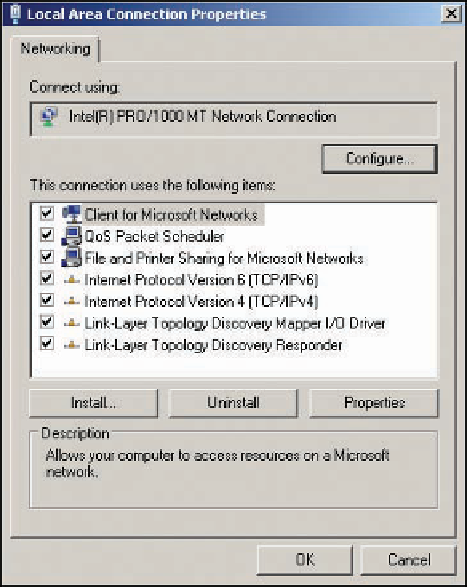Information Technology Reference
In-Depth Information
8
Figure 8-9
The Local Area Connection Properties dialog box
performance level. By default, QoS Packet Scheduler allows reserving up to 20% of the
bandwidth. This value can be changed in a computer's local group policy or with a
domain GPO in the Computer Configuration\Administrative Templates\Network\QoS
Packet Scheduler node.
•
File and Printer Sharing for Microsoft Networks
—This service, the complement to Client
for Microsoft Networks, allows a computer to host shared resources that are accessible by
computers using Client for Microsoft Networks. Unbinding this service from a network
connection effectively prevents client computers from accessing shared folders or printers
through that connection. For security reasons, users whose computers have connections to
both a private and public network should usually disable File and Printer Sharing for
Microsoft Networks on the connection to the public network.
•
Internet Protocol Version 6 (TCP/IPv6)
—IPv6, the eventual successor to IPv4, is installed
by default in Windows Server 2008 and Vista, but if your network does not use it, dis-
abling it on your network connections is safe. IPv6 is discussed later in “Internet Protocol
Version 6.”
•
Internet Protocol Version 4 (TCP/IPv4)
—IPv4 remains the most widely used protocol on
networks. Until IPv6 replaces it as the standard protocol on LANs and the Internet, this
protocol should be bound to your network connections.
•
Link-Layer Topology Discovery Mapper I/O Driver
—The LLTD protocol is used to build
the network map in the Network and Sharing Center. On network connections where you
don't want to create a network map, you can unbind this protocol safely.
•
Link-Layer Topology Discovery Responder
—LLTD responds to requests from the LLTD
Mapper I/O Driver so that a computer running this protocol can be placed on a network
map. This protocol is installed by default in Vista and Windows Server 2008 and can be
downloaded and installed on Windows XP computers so that they can appear on a map.
On network connections where you don't want the computer to appear on a map, you can
unbind this protocol safely.


Search WWH ::

Custom Search